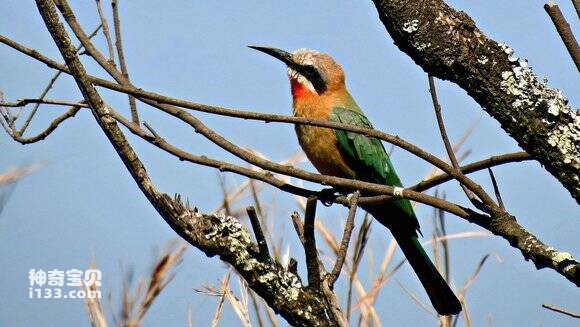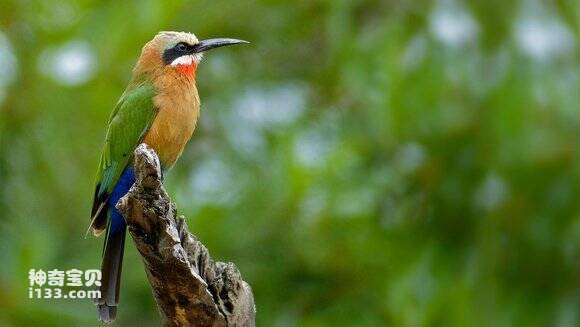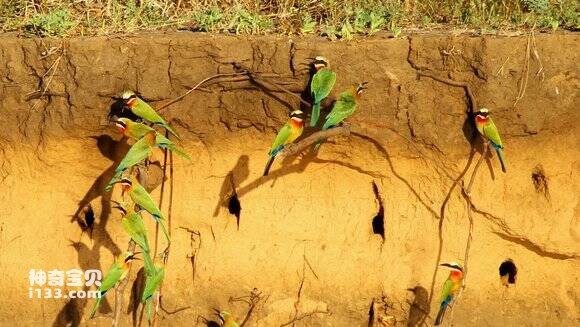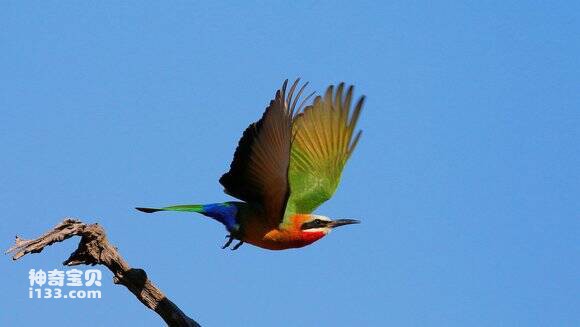Merops bullockoides
IUCN
LCBasic Information
Scientific classification
- name:Merops bullockoides
- Scientific Name:Merops bullockoides,White-fronted Bee-eater
- Outline:Climbing birds
- Family:
Vital signs
- length:22-24cm
- Weight:28-35g
- lifetime:No textual research information is available
Feature
It has a white forehead and a fawn brown head, back and neck
Distribution and Habitat
It is distributed in Angola, Botswana, Burundi, Congo, Democratic Republic of the Congo, Gabon, Kenya, Malawi, Mozambique, Namibia, Rwanda, South Africa, Eswatini, United Republic of Tanzania, Zambia, Zimbabwe.
White-fronted humes are frequent in dry river beds, shrubland, grasslands, woodlands, and seasonal rivers. It mainly inhabits the savannas of the African subequatorial belt. Its habitat includes vast rural areas, especially near ditches.
Appearance
White-fronted bee-eaters are 22-24 cm long and weigh 28-35 g for males and 31-38 g for females. Female adult birds are larger than males. White-fronted bee-eaters are brightly coloured, with a white forehead and a fawn brown head, back and neck. The eyebrows are white, the eyes, eye stripes, cheeks and ear feathers are covered by black, and there is a white band on the lower side. White chin. The upper body is green, the lower body is cinnamon, and the tail feathers are blue ultramarine. The primary feathers have black piping. The bright red throat contrasts with the red chest and pale yellow belly. Perianal and tail blue. The tail is light yellow, and the cover is black. The beak is black. Iris dark brown, feet dark gray.
The mouth is slender and the nostrils are bare; Body feathers are dense, normal and without longitudinal lines; The tail is convex, the central tail feathers are elongated and the ends are narrow or pointed, and the middle toe and outer toe are often connected to
Details
The White-fronted Bee-eater is Merops bullockoides, or white-fronted bee-eater, and has two subspecies.

White-fronted bee-eaters often travel in groups. Most of the day is spent in the air, flying straight and fast, with rapid flapping of the wings, sometimes accompanied by gliding. Not afraid of people, sometimes into the cottage, house behind the house and orchard activities, rest on the wire, dead branches or shrubs. Hunting on the fly.

White-fronted bee-eaters mainly eat bees, which account for nearly 50% of their food source. They also eat other flying insects such as beetles, bedbugs, flies, crickets, termites, dragonflies, damselflies, etc. But it depends on the season and the number of prey. They hunt from low tree branches or glide down to catch insects. Their call is a low creak.
White-fronted bee tigers, whose colonies average 200 individuals, dig burrows on cliffs or banks to nest. Their communities can span several square kilometers of savannah, but return to the same place to roost, live and breed. They have the most complex social system of any bird. White-fronted bee-beetles are in one-to-one social relationships where groups cooperate in reproduction, with infertile members helping other members raise their chicks. They will help build more than half of the nests and will act as helpers in the breeding process, including digging nests, feeding females, hatching and feeding chicks, etc., which has a great impact on the number of chicks born. Females lay an average of 3-8 eggs during the breeding season, which varies from place to place and is determined by rainfall and temperature: April to June in Kenya, August to September in Zambia and Angola, February and April in Zimbabwe, and September to October in South Africa.

Listed on the International Union for Conservation of Nature (IUCN) 2013 Red List of Threatened Species ver 3.1 - Low Risk (LC).
Protect wild animals and eliminate wild meat.
Maintaining ecological balance is everyone's responsibility!








